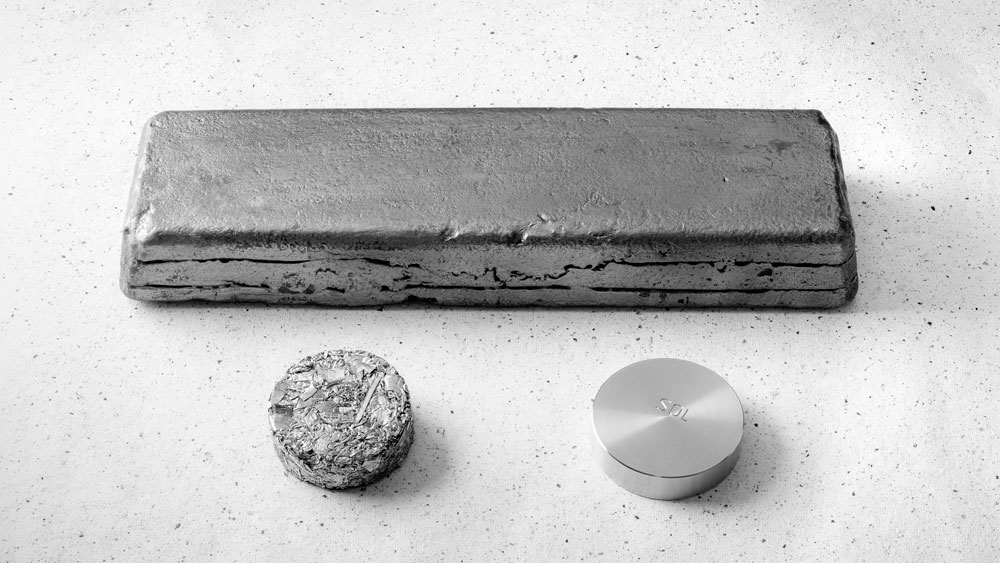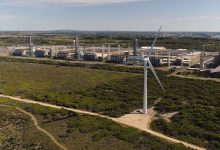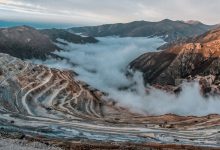World’s First Industrial Solar Furnace to Melt Steel Without Fuel or Electricity
Swiss microtechnology company Panatère, a watch component manufacturer and steel recycling business based in Saignelégier, has announced that it will soon inaugurate its concentrating industrial solar furnace. A pilot model – and a world first – that will allow it to melt green steel, locally, to produce components for the watchmaking, medical and aeronautical sectors.
Melting steel using solar energy is the bet Panatère is about to win. A manufacturer of steel and stainless-steel watch components, the company will in a few months be the first in the world to use an industrial solar furnace to melt metal.
“Our material will be 100% recycled and melted using renewable energy,” proudly says Liselotte Thuring, project manager. Instead of sourcing recycled metal bars from China, Panatère plans to produce and use its own steel. In addition to its own waste, the company will collect its raw material (chips and other waste) locally, over an area of 50 km2, from the region’s machinery processing companies in the form of ingots. They will then be used for their own production or sold to similar companies involved in other fields of activity.
Near-zero environmental and energy costs
Rather than gas or electricity, Panatère is preparing to use direct sunlight to recycle steel. It has equipped itself with a powerful concentrating solar furnace, which will allow it to melt metal with near-zero environmental and energy costs.
For the first time, steel will be industrially recycled from the heat of the sun alone. The solar furnace could melt up to 400 tons of recycled steel each year. The ingots will be reused by Panatère or sold to other companies.
The furnace will reach a temperature of 2,000°C, which is more than enough because the melting point of steel, stainless steel and titanium is between 1,400 and 1,700°C. To do this, the device will need to concentrate the power of solar radiation to a single point with the help of mirrors.
This is the principle of ‘concentrated solar power’, which is also used in thermodynamic plants and scientific furnaces. The Panatère industrial facility is therefore a world first. Steel has never been commercially melted using only the sun’s energy.
Developed in partnership with the École polytechnique fédérale de Lausanne, Panatère’s solar oven will be 15 m wide and 6 m high. It consists of two surfaces covered with mirrors arranged differently. The first, completely flat, directs the rays towards the second, concave. The latter generates a highly focused beam of light directed at the cell in which the metals to be melted are located.

Up to 400 tons of steel and titanium recycled every year
Panatère plans to melt 50 tons of steel and titanium from 2023. It hopes to increase this volume to 400 tons/year by 2026, thanks to the creation of a ‘Solar Metal Processing Center’ that will operate with 4 solar furnaces in one location.
Compared to new steel, recycled steel thanks to sun would make it possible to split the carbon footprint of the business to 165, the company promises. Costs and production rates will not depend on gas and electricity prices, but only on the weather, which is ultimately not so restrictive in the current context. The investment amounts to more than EUR 25 million and the first solar oven is expected to be commissioned before the end of the year.
Reaching temperatures between 250°C and 3,000°C, the industrial solar oven is the upgraded version of household solar cookers and professional solar cookers developed for craftsmanship.
Operating on the principle of concentrating solar radiation, the advantages are that the energy used is inexhaustible and non-polluting, the chemical purity is high (ideal for experiments, there is no combustion gas) and high temperatures are reached quickly. The disadvantage is that it depends on the sun.
How did the adventure begin
The Panatère adventure began five years ago when its founder, Raphaël Broye, had the idea to transform a problem into an ecological solution. “We have been active in watchmaking subcontracting for around forty years and five years ago we found ourselves faced with major problems with the supply of quality steel,” he explains. “We approached several large steelmakers in Europe but found ourselves faced with quantity problems. Our request did not interest anyone. This is where we had the idea of setting up a network of partners from watchmaking and medical subcontracting in the Jura arc to pool the collection of our waste. We have all installed sorting and collection bins at the gates of our factories and, once all our waste has been grouped together, after four years we have succeeded in putting together a first batch of 50 tons.”
In December 2021, the company melted its first ingot using solar energy in an industrial furnace in the French Pyrénées.
Parkent solar furnace from Uzbekistan
Parkent is one of the two largest solar furnaces in the world (together with the one at Odeillo in France). Commissioned in 1987, Parkent is slightly larger, with a mirror surface area of 1,840 m2 (compared to 1,830 m2) but does not benefit from the same incident solar intensity because the altitude is lower (1,050 m compared to 1,600 m), so it is less powerful, with a usable maximum of 700 kW instead of the 1,000 kW at Odeillo. On the other hand, the optical quality is similar, with a maximum power density of 1,000 W/cm2, which makes it possible to exceed 3,000°C according to the experiment.
The Academy of Sciences of Uzbekistan, through its Solar Physics Laboratory, conducts research there on such topics as the synthesis of new refractory oxides (more than 160 materials synthesized, including alumina) and the development of solar pump lasers.
Odeillo solar furnace
Bigger than the Arc de Triomphe, the Odeillo Solar Furnace is a solar-powered oven. It is the world’s first semi-industrial sized solar furnace. Its parabola has been registered as a Historic Monument since 2009. It houses the PROMES laboratory, an internationally renowned CNRS Research Unit.
Built between 1962 and 1968, the Odeillo solar furnace was commissioned in 1970 for scientific research. It is one of the largest furnaces in the world, (the other being in Uzbekistan) is 54 m high and 48 m wide, is composed of 63 heliostats (mirrors) and has a power of 1,000 kW.
The Odeillo Solar Furnace is a CNRS (UMR) research laboratory accredited by the University of Perpignan (Pyrénées-Orientales) on high temperature thermal studies, heat transfer systems, energy conversion, high temperature material behavior in extreme environments. Research areas are extended to the aerospace industry.
After the first oil shock in 1973, researchers at the Odeillo solar furnace turned their attention more to converting solar energy into electricity and hybridizing energy production.
This oven has several advantages:
- Temperatures above 3,300°C can be achieved in seconds, depending on the process implemented. Energy is ‘free’ and clean.
- The operating cost is low.
- This furnace makes it possible to obtain sudden temperature changes and therefore to study the effect of thermal shocks.
- There are no contaminants (flue gas, pollution, residues etc.), as only the object being processed is heated exclusively by radiation.
- Heating can be carried out in a controlled atmosphere, making it possible to reproduce the vacuum of space.
Mont-Louis solar furnace
The world’s first experimental solar furnace is built in Mont-Louis thanks to year-round sunshine.
In 1947, Professor Félix Trombe decided to settle in Mont-Louis to build the world’s first solar oven in 1949. Commissioning took place in 1951.
The Mont-Louis solar furnace works on the principle of double reflection. The sun’s rays are reflected for the first time by the heliostat, which then returns them parallel to the concentrator, which in turn reflects them a second time, concentrating them 6 metres ahead at the paraboloid’s focal point.
The furnace uses mirrors to concentrate sunlight onto an area with a small diameter, known as the receiver, to produce heat as high as 7,230 degrees Fahrenheit, or 4,000 degrees Celsius.
Ancestor of today’s solar ovens
The solar oven in Sorède was used for one of the first experiments of its kind in the world. It is the fruit of the work of the Portuguese Manoel Antonio Gomes known as ‘Padre Himalaya’, who was a physicist and a monk.
His solar oven is of the ‘Pyrhéliophore’ type as indicated on the explanatory panel installed on site. In the summer of 1900, craftsmen in Sorède assembled and then installed the scientist’s machine using mules. This oven consisted of a dish several metres in diameter fitted with small glass mirrors arranged in staggered rows and fixed to a metal structure that could be oriented towards the sun. The sun’s heat concentrated by mirrors onto an oven at the center of the installation allowed the scientist to achieve a temperature of 2,500 in August 1900.
Today you can still see the circular concrete track on which the machine pivoted and also the remains of the platform built of dry stones. Therefore, this is where the world’s first solar oven was born.
After conducting a series of experiments for three months under the old castle of Ultrera, the scientist moved his equipment and left to continue his work in the United States, where he built a much larger solar oven in St. Louis, in 1904.
The municipality of Sorède remains the first in the world to host an experimental solar energy platform on its territory, the scientific applications of which will be further developed, notably in Mont-Louis and Odeillo.
Artificially intelligent solar furnace that can produce cement and steel without CO2
Heliogen, a leading provider of AI-enabled concentrated solar energy technology, can produce extreme heat that can be used in carbon-intensive industries. The technology, which relies on concentrated solar thermal processing, is augmented by artificial intelligence.
A very high temperature solar furnace that doesn’t burn fossil fuels is a major breakthrough in the fight against global warming, says Bill Gross, Founder and CEO of Heliogen. At its concentrated solar thermal demonstration facility in Lancaster, California, Heliogen has developed a prototype solar power plant equipped with artificial intelligence that would be capable of generating extreme heat, above 1,000°C. Enough to produce cement, steel and even hydrogen with very low CO2 emissions.
This plant is based on the Concentrated Solar Thermal Power (CSP) process: many mirrors, called heliostats, reflect the sun’s rays to a container fixed on top of a tower, which are then converted into heat in the form of steam. For demonstrations, about 400 smaller mirrors were placed on the floor, which are cheaper and easier to transport and install. The principle is not new, but the company claims it can take it much further. “So far, the heat has reached between 500 and 600°C,” Bill Gross points out. Enough to generate electricity through rotating turbines. But doubling this temperature would open up new opportunities by unlocking a series of chemical reactions.
“Our technology is ten times more accurate, while offering lower costs because we no longer need to do solar radiation studies and recalibrate mirrors for parameters that can vary,” says Bill Gross.
The Heliogen plant is not the first to exceed 1,000°C. Some plants can even reach much higher temperatures: over 3,000°C for the Odeillo solar furnace in the Eastern Pyrenees, for example. But this site, operated by CNRS, is used for research purposes, in particular in the European SOLPART project. Like the Parkent solar furnace in Uzbekistan, it is also gigantic – 54 metres high and 48 metres wide. But Heliogen is counting on much smaller plants that can be deployed in a few weeks and at a lower cost near industrial sites.
Challenge of integration in industrial processes
“More than 1,000 companies contacted us in the week following the presentation of our technology,” explains the head of Heliogen. “Small and large companies, including a major mining group that wants to reduce its energy consumption. Their interest is first and foremost economic,” admits Bill Gross, who assures that the initial investment should pay for itself in two to three years.
For Heliogen, the difficulty is compounded by the need to adopt a hybrid system, which runs on fossil fuels when the sun is not shining. This is also another limitation of this technology, which can only be developed in areas with strong sunlight. Not forgetting the space required: less than half a hectare of land for each megawatt of power. Bill Gross admits that half of the world’s industrial sites are too small.
Heliogen wants to focus first on a few specific sectors, such as cement and steel, the production of which requires very high temperatures, which today can only be achieved using fossil fuels. According to the International Energy Agency, the cement industry alone accounts for 7% of global emissions. “They don’t have a way to use renewable energy,” notes Bill Gross. In the long term, when his solar furnace can reach 1,500°C, the entrepreneur hopes to produce hydrogen, which today comes mainly from fossil fuels.






